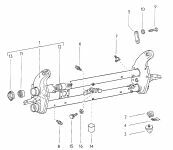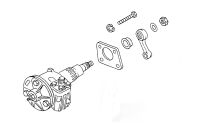Mechanical areas to check when buying
a Bay-window
(68-79) Volkswagen van!
Click any image to enlarge
Front Beam or axle
The VW Bay-Window uses torsion bars at the front for suspension as opposed to the
now universal coil springs. The torsion bars are contained within two axle tubes which
together are commonly known as the Front Beam. The beam is a substantial piece
of engineering and gives the VW its smooth (for its year) ride and strength.
Get underneath the van, no need to raise the front due to the ground clearance and take with you
a screwdriver to have a good poke around. Check all over for signs of rust using the screwdriver to poke
through any under seal that may have been used to protect the beam or hide rust. Look for repair patches.
There is nothing wrong with repairs as long as they are completed to a high standard. Does the
welding look good? Or does it look like its been thrown on?
 Areas of rust to especially look for are around the steering pivot point in the centre and
also the two turrets which join the two axle tubes together. There are 3 grease nipples on the beam.
Check each for signs of greasing. If the centre grease nipple has not been filled for a long
time, this can cause the steering pivot bearing to wear or seize. If the beam has been filled with grease,
then grease should be visible at the axle tube ends around the dust cover. Check to see if this area is dry.
Areas of rust to especially look for are around the steering pivot point in the centre and
also the two turrets which join the two axle tubes together. There are 3 grease nipples on the beam.
Check each for signs of greasing. If the centre grease nipple has not been filled for a long
time, this can cause the steering pivot bearing to wear or seize. If the beam has been filled with grease,
then grease should be visible at the axle tube ends around the dust cover. Check to see if this area is dry.
While still under the van, look at the shock absorbers for signs of oil leaks on the body of the damper,
missing dust shields and general damage. Bent damper roads are not unknown but luckily are cheap to replace. To check a
dampers operation, return from under the van and give a good push down on each corner.
The van should move downwards, rise once and settle in its normal position. If the van
oscillates more than once, the dampers are worn. Worn dampers will cause the tracking to go out of alignment
and lead to a lack of stability in corners and in crosswinds.
Look at the front of the van when it is parked on level ground. Does the van sit level? Assuming that
the tyre pressures are equal and the dampers are not worn then sitting un-even could mean a broken torsion bar
within the beam. If the beam has been lowered, check it has been carried out properly. A cheap way
of lowering a VW is to cut a section out of the front axle and rotate it around and re-weld it in position.
This is a substandard method of lowering the front as the position is hit and miss and non-adjustable plus it adversely
affects the ride quality and is said to weaken the torsion bars over a period of time as the
torsion bars are under a greater pre-load all the time. The preferred way of lowering the beam is to have
an adjuster welded into position such as the Folksy adjuster from Bluebird conversions.
If the van needs a new beam, all is not lost but the cost to replace is considerable. It takes at least
a days labour to change and second hand beams are difficult to find with prices varying from
£50 to £200. Two types of beam are available 1968-1970 and 1970 onwards, The early beams are more difficult
to find plus they are always in demand by Split screen van owners as they are interchangeable and have the
benefit of ball joints over king pins.
Steering
The steering uses a steering box instead of the now more familiar steering rack
(though Mercedes still used steering boxes on there luxury cars well into the 1990's).
The steering box is positioned under the front belly pan, right at the front of the van
on the offside, bolted to the front chassis cross member.The amount of play at the steering wheel
is the only way of checking a steering box for wear. About 10-15mm of free movement in each direction
is quite normal with any more indicating wear or lack of adjustment. The steering box can be adjusted to take up
play to an extent but if over adjusted, the steering will be stiff.
 Venture under the van and check the rubber coupling that connect the steering box to the steering
column for cracks. The coupling connects the steering box to the steering column by 4 bolts. Cost
of the coupling is approximately £10. While under the van, look at the steering box for obvious damage,
burrs on the adjustment nut indicating adjustment and oil leaks. The are 2 types of steering boxes used on the
Type 2 Bay Window range. Earlier vans had a steering box made from cast iron which are becoming
difficult to find and later steering boxes that had a body cast from alloy. The 2 boxes are not
interchangeable. A reconditioned steering box costs £200 plus while a second hand steering box costs
between £30 and £100.
Venture under the van and check the rubber coupling that connect the steering box to the steering
column for cracks. The coupling connects the steering box to the steering column by 4 bolts. Cost
of the coupling is approximately £10. While under the van, look at the steering box for obvious damage,
burrs on the adjustment nut indicating adjustment and oil leaks. The are 2 types of steering boxes used on the
Type 2 Bay Window range. Earlier vans had a steering box made from cast iron which are becoming
difficult to find and later steering boxes that had a body cast from alloy. The 2 boxes are not
interchangeable. A reconditioned steering box costs £200 plus while a second hand steering box costs
between £30 and £100.

Home
 Areas of rust to especially look for are around the steering pivot point in the centre and
also the two turrets which join the two axle tubes together. There are 3 grease nipples on the beam.
Check each for signs of greasing. If the centre grease nipple has not been filled for a long
time, this can cause the steering pivot bearing to wear or seize. If the beam has been filled with grease,
then grease should be visible at the axle tube ends around the dust cover. Check to see if this area is dry.
Areas of rust to especially look for are around the steering pivot point in the centre and
also the two turrets which join the two axle tubes together. There are 3 grease nipples on the beam.
Check each for signs of greasing. If the centre grease nipple has not been filled for a long
time, this can cause the steering pivot bearing to wear or seize. If the beam has been filled with grease,
then grease should be visible at the axle tube ends around the dust cover. Check to see if this area is dry.
 Venture under the van and check the rubber coupling that connect the steering box to the steering
column for cracks. The coupling connects the steering box to the steering column by 4 bolts. Cost
of the coupling is approximately £10. While under the van, look at the steering box for obvious damage,
burrs on the adjustment nut indicating adjustment and oil leaks. The are 2 types of steering boxes used on the
Type 2 Bay Window range. Earlier vans had a steering box made from cast iron which are becoming
difficult to find and later steering boxes that had a body cast from alloy. The 2 boxes are not
interchangeable. A reconditioned steering box costs £200 plus while a second hand steering box costs
between £30 and £100.
Venture under the van and check the rubber coupling that connect the steering box to the steering
column for cracks. The coupling connects the steering box to the steering column by 4 bolts. Cost
of the coupling is approximately £10. While under the van, look at the steering box for obvious damage,
burrs on the adjustment nut indicating adjustment and oil leaks. The are 2 types of steering boxes used on the
Type 2 Bay Window range. Earlier vans had a steering box made from cast iron which are becoming
difficult to find and later steering boxes that had a body cast from alloy. The 2 boxes are not
interchangeable. A reconditioned steering box costs £200 plus while a second hand steering box costs
between £30 and £100.